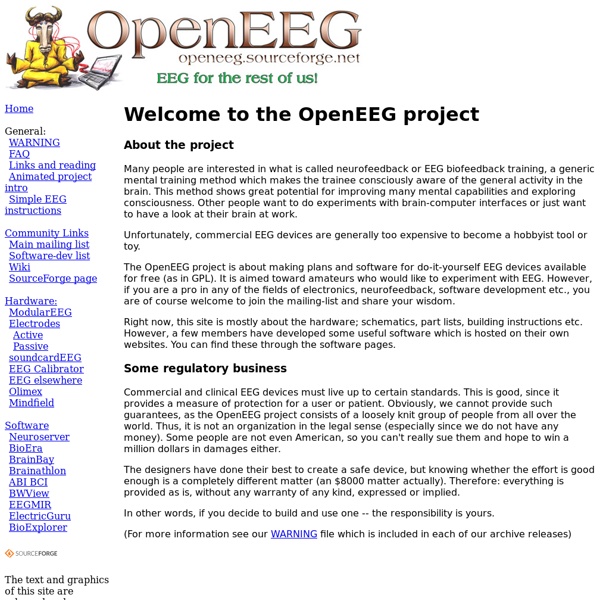



DSPdap - A DSP based Digital Audio MP3 Player & Recorder with USB pen drive funtionality, using a 16-bit fixed point Texas Instruments TMS320 C55x DSP and CompactFlash card. This is an open source and open hardware MP3 player project Arduino-Brain-Library
Human Trial Suspended Animation Treatment Set to Begin at Mass General LSDBase | Measuring the Effects of Lucidity on Dreams Farm Fountain - a sculptural ecosystem you can eat EEGLAB EEGLAB provides an interactive graphic user interface (GUI) allowing users to flexibly and interactively process their high-density EEG and other dynamic brain data using independent component analysis (ICA) and/or time/frequency analysis (TFA), as well as standard averaging methods. EEGLAB also incorporates extensive tutorial and help windows, plus a command history function that eases users' transition from GUI-based data exploration to building and running batch or custom data analysis scripts. EEGLAB offers a wealth of methods for visualizing and modeling event-related brain dynamics, both at the level of individual EEGLAB 'datasets' and/or across a collection of datasets brought together in an EEGLAB 'studyset.' For experienced Matlab users, EEGLAB offers a structured programming environment for storing, accessing, measuring, manipulating and visualizing event-related EEG data. EEGLAB Statistics EEGLAB Workshops EEGLAB Development Feedback?
5-HT2A receptor The mammalian 5-HT2A receptor is a subtype of the 5-HT2 receptor that belongs to the serotonin receptor family and is a G protein-coupled receptor (GPCR).[1] This is the main excitatory receptor subtype among the GPCRs for serotonin (5-HT), although 5-HT2A may also have an inhibitory effect[2] on certain areas such as the visual cortex and the orbitofrontal cortex. This receptor was first given importance as the target of serotonergic psychedelic drugs such as LSD. Later it came back to prominence because it was also found to be mediating, at least partly, the action of many antipsychotic drugs, especially the atypical ones. 5-HT2A may be a necessary receptor for the spread of the human polyoma virus called JC virus.[3] Downregulation of post-synaptic 5-HT2A receptor is an adaptive process provoked by chronic administration of SSRIs and classical antipsychotics. History[edit] Distribution[edit] Signaling cascade[edit] Effects[edit] Physiological processes mediated by the receptor include:
Introduction To Modern Brain-Computer Interface Design - SCCN Overview Christian Kothe This is an online course on Brain-Computer Interface (BCI) design with a focus on modern methods. The lectures were first given by Christian Kothe (SCCN/UCSD) in 2012 at University of Osnabrueck within the Cognitive Science curriculum and have now been recorded in the form of an open online course. The course includes basics of EEG, BCI, signal processing, machine learning, and also contains tutorials on using BCILAB and the lab streaming layer software. Online Videos Course Overview Videos • Quick Teaser for the Course • Course Outline (slides) Part I: Introduction to BCI Design • Lecture 1: Introduction (slides) • Module 1.1: What is a Brain-Computer Interface? • Module 1.2: Application Areas and Examples • Module 1.3: Scientific Challenge • Module 1.4: Available Tools • Demo 1: The Lab Streaming Layer (slides) • Lecture 2: EEG Basics (slides) • Module 2.1: Underlying Brain Processes • Module 2.2: Spatial Characteristics • Module 2.3: Temporal Characteristics • Module 5.1: Task
Neo 1973 The Neo 1973 was designed as open source hardware. It is mostly using hardware components with open source drivers, the CAD files have been released under a ShareAlike Creative Commons license,[2] and the schematics are available for download from OpenMoko[3] and Wikimedia Commons [4] under a Creative Commons Attribution ShareAlike license. The Neo 1973 was sold from July 9, 2007 to February 2008. The initial releases of the Neo 1973 were hampered by supplier shortages, which forced the shipping date to slip, and hardware development difficulties exacerbated by the small size of the core team.[6] The next version of the phone, Neo FreeRunner, started shipping on June 24th, 2008. See also[edit] References[edit] External links[edit] Neo 1973 article on the OpenMoko wiki